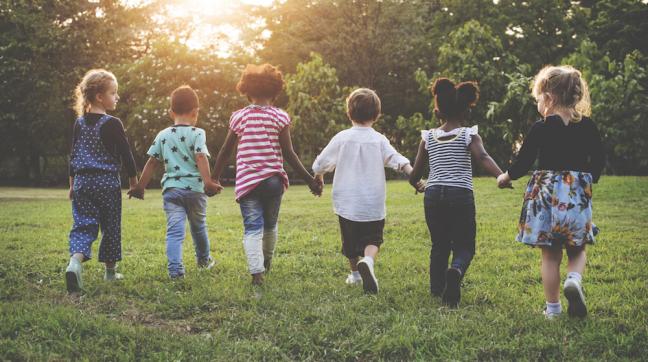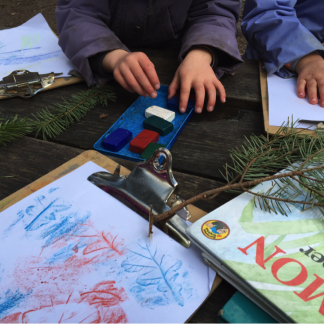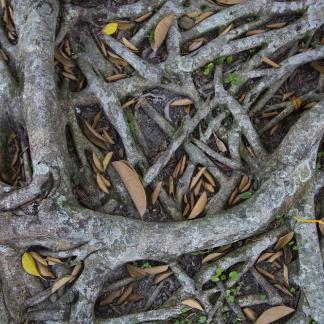We carry our cultures with us in everything we do. They’re all around us—in the activities we give our time to, the roles we ascribe to, the language we speak, the food we eat. When children see their families’ culture represented in their education, they are significantly more likely to develop positive identities, engage fully in their education, and, ultimately, succeed. Yet, young children who attend our schools and programs each come from a home culture that may be different from our own. So how do we make space for and invite these cultures into our nature-based early childhood classrooms and programs? By celebrating the diversity of our families and community every day, in everything we do!
Following are six tips for affirming and celebrating multicultural experiences in nature-based early learning. The first three focus on cultivating your own cultural empathy, while the last three will help you bring a multicultural lens to your teaching practices.
1. Reflect. This first step can feel like a non-action, but it provides the vital roots for your growing cultural empathy. Begin by considering your own cultural heritage. What culture do you come from, and how has it shaped who you are today? Think about the clothes you wear, when and what you eat, and your attitudes towards work, leisure, and money. Also reflect on the influence of your cultural upbringing on your views on education and its role in children’s lives.
Next, consider what assumptions and biases about others your culture has taught you. These are often learned passively from the cultures we grow up in. While they can feel challenging to identify and confront, don’t worry: most of us have them, even those of us working to unlearn them. What matters most is that you’re actively engaged in addressing and unlearning yours.
2. Be curious and listen. Now that you have a foundation to think and talk about your own culture, begin asking friends or co-workers about aspects of theirs. You can also seek out local institutions or events where you can learn about other cultures represented in your community.
Try leading into these conversations with friendly observations about something you notice and follow up with a respectful question. For example, if you notice that a co-worker often shares about large family gatherings, you might say, ”I’ve noticed that you gather with your family often. Are close family connections important to you?” When a person starts sharing, focus on listening and showing your interest. Let them know that you’re trying to learn more about other people’s cultures and that you appreciate them talking with you.
Once you’ve practiced this with people you know well, begin to notice and take opportunities to ask families in your program about their traditions, celebrations, languages, and histories. Because you may only have time for short conversations with families at drop-off and pick-up times, make notes of things you remain curious about or realize you know nothing about. This will bring you to:
3. Do some research. It’s important to remember that it’s not other people’s responsibility to teach you about their culture. This means that, as your curiosity develops and as you start to understand what you still need to learn about other cultures, you are responsible for doing some research and finding the answers.
This might mean reading books written by and about members of the culture you are interested in. If a co-worker identifies as a member of the same culture you want to learn more about, you can ask for guidance and recommendations. Again, you might also be able to find leaders and organizations in the community whose work it is to educate others about their cultural practices. Whenever you speak to someone, though, be sure to thank them for sharing.

4. Analyze your curriculum for hidden messages. How and what we teach sends a message to children and families that is often unintended—a hidden curriculum. This hidden curriculum can teach about what cultures are worth valuing by giving unbalanced attention to one culture. For example, a curriculum that teaches only European folklore to a diverse group of students is unintentionally showing students that stories, myths, and lore from other places and cultures aren’t worth talking about.
On the other hand, a curriculum that includes tales from many places and cultures, particularly all those with which students identify, shows children that they belong in your program and that all cultures have stories worth hearing.
5. Include students’ cultures in your daily routine. The key element of this tip is daily. Making your students’ cultures a part of every day will help you to avoid only recognizing cultures on specific holidays, a practice that can send a hidden message about which cultures are central and which are worth only a once-a-year visit. That said, celebrating multicultural holidays can be valuable as long as it is supported by including elements of that culture in your curriculum the rest of the year as well.
You can begin incorporating students’ cultures into your daily routine with simple practices such as greeting children and families in their home language and expanding your menu to include children’s favorite dishes from home. You can also ask about and get to know the family members each child lives with or sees regularly.
6. Invite family (and community) members to visit your classroom or program. Families are children’s first teachers and the real experts when it comes to their home culture. Make sure families know that they have an open invitation to visit your classroom or program and observe, play, or share a favorite story. This will create openings to learn more about your students and their culture, and it will offer your families opportunities to feel connected to their children’s education and demonstrate what that connection looks like to them.
If your student population is fairly homogenous, consider inviting community members to your classroom or program to share a skill, job, or passion that relates to your curriculum. This can provide your students with more opportunities to see that people from different cultures in their community are valued teachers and co-learners.
Developing cultural empathy and creating more inclusive nature-based programs are journeys that require dedicated reflection, curiosity, self-assessment, commitment, and initiative. What specific steps can you take to increase your cultural empathy and welcome children with diverse cultural heritages into your nature-based program?
Suggestions for Further Reading
Critical Practices for Anti-bias Education, from Teaching Tolerance
Reading Your Way to a Culturally Responsive Classroom, by Shannon B. Wanless & Patricia A. Crawford
English Language Learners and Culturally Responsive Teaching, Rule 1, by Veronica Vasquez
About the Author
Sarah Foglesong is Associate Faculty and Program Director at the Center for Nature and Place-Based Early Childhood Education at Prescott College. Before joining the NPECE Center, Sarah taught in a variety of early childhood and environmental education programs. She is particularly interested in providing early childhood educators with the training, tools, and support they need to bring nature-based learning into their classrooms as well as in finding ways to bring environmental education to young children and their families in diverse settings and circumstances.




